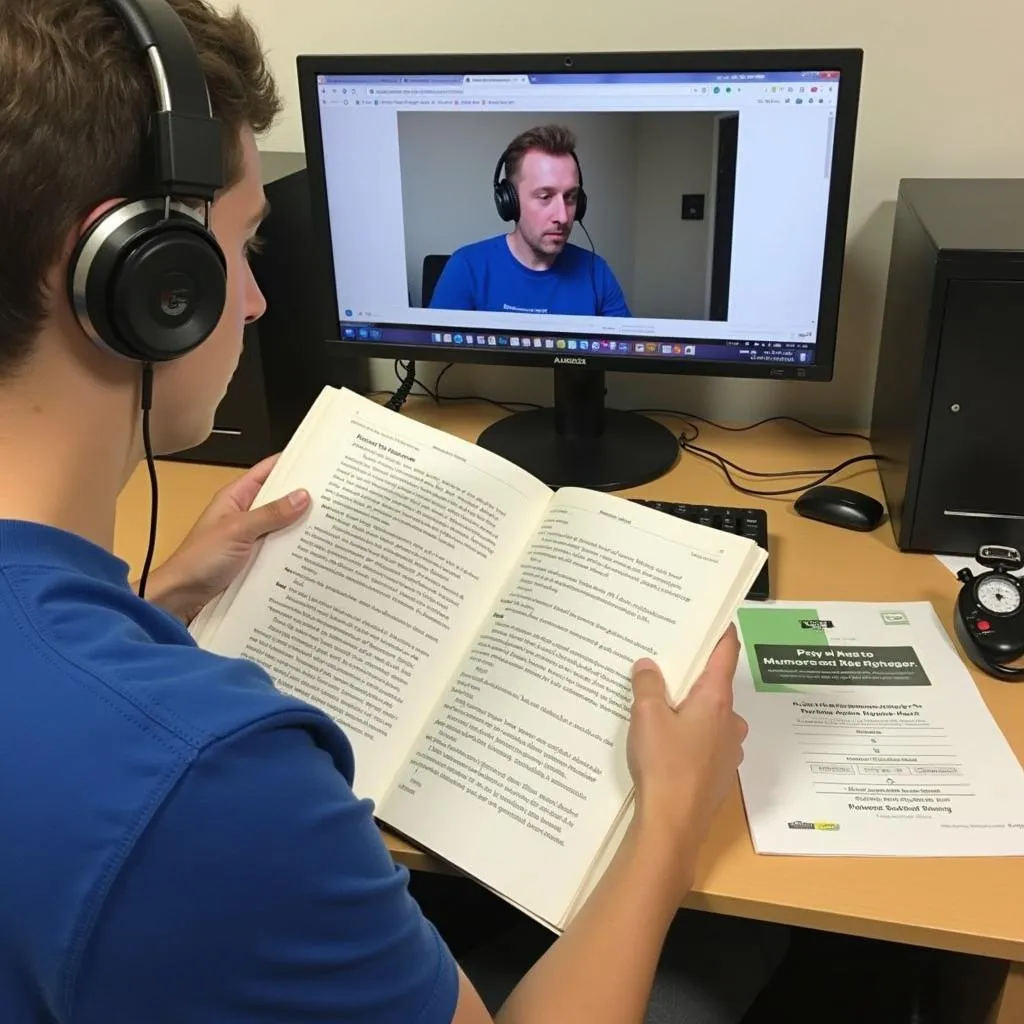Reading aloud is a crucial component of the PTE Speaking module, testing your ability to read fluently and accurately. Mastering this skill can significantly boost your overall PTE score. In this comprehensive guide, we’ll explore effective strategies on How To Practice Reading Aloud For PTE Speaking, helping you gain confidence and achieve your desired results.
Understanding the Reading Aloud Task
Before diving into practice techniques, it’s essential to understand the format and requirements of the PTE reading aloud task. This section of the PTE academic speaking module format evaluates your pronunciation, fluency, and intonation as you read a given text aloud.
Key Aspects to Focus On:
- Pronunciation: Clear articulation of words
- Fluency: Smooth and natural speech flow
- Intonation: Appropriate stress and rhythm
- Timing: Completing the task within the given time frame
Effective Strategies for Reading Aloud Practice
- Start with Familiar Texts
Begin your practice with texts you’re comfortable with. This could be newspaper articles, short stories, or even your favorite book passages. Familiarity with the content allows you to focus on your delivery rather than struggling with comprehension.
- Record and Analyze Your Performance
One of the most effective ways to improve is by recording yourself and critically analyzing your performance. This method helps you identify areas for improvement that you might not notice while speaking.
“Recording yourself is like having a personal coach. It allows you to hear your mistakes and track your progress over time,” says Dr. Emma Thompson, a renowned PTE speaking coach.
- Shadow Native Speakers
Listening to and mimicking native English speakers can significantly enhance your pronunciation and intonation. Use podcasts, audiobooks, or PTE practice materials for this purpose.
 Effective techniques for PTE reading aloud practice
Effective techniques for PTE reading aloud practice
- Practice with PTE-specific Materials
While general reading practice is beneficial, incorporating PTE-specific materials into your routine is crucial. These texts are designed to match the difficulty level and format of the actual exam.
- Focus on Stress and Intonation
English is a stress-timed language, meaning certain syllables and words are emphasized more than others. Pay attention to stress patterns and intonation to sound more natural and fluent.
- Use a Mirror
Practicing in front of a mirror allows you to observe your mouth movements and facial expressions, helping you improve articulation and overall delivery.
- Break Down Complex Words
When encountering difficult words, break them down into syllables. Practice pronouncing each syllable separately before combining them.
- Time Your Practice Sessions
The PTE reading aloud task has a strict time limit. Practice reading within this time frame to develop a sense of pacing.
Common Mistakes to Avoid
- Rushing through the text
- Monotone delivery
- Ignoring punctuation
- Mispronouncing common words
- Over-emphasizing every word
Building Confidence for PTE Speaking
Confidence plays a crucial role in your performance. How to develop confidence for PTE speaking is an essential aspect of your preparation. Regular practice, positive self-talk, and familiarizing yourself with the test format can significantly boost your confidence levels.
Enhancing Your Vocabulary
A robust vocabulary is essential for smooth reading aloud. Implement PTE vocabulary building strategies to expand your word bank and improve your overall performance.
 Methods to enhance vocabulary for PTE reading aloud
Methods to enhance vocabulary for PTE reading aloud
Practicing with Sample Questions
Familiarizing yourself with the types of texts you might encounter in the exam is crucial. Review PTE speaking section sample questions to get a feel for the difficulty level and content variety.
Creating a Structured Practice Routine
Consistency is key when preparing for the PTE exam. Create a structured practice routine that includes:
- Daily reading aloud sessions (at least 30 minutes)
- Regular recording and self-assessment
- Focused practice on problem areas
- Timed practice sessions
- Periodic mock tests
“A structured practice routine is the backbone of PTE success. It’s not about practicing more, but practicing smarter,” advises Mark Johnson, PTE preparation expert.
Utilizing Technology for Practice
Take advantage of technology to enhance your practice:
- Speech recognition software for pronunciation feedback
- PTE practice apps for on-the-go learning
- Online forums for peer feedback and support
Conclusion
Mastering the art of reading aloud for PTE speaking requires dedication, consistent practice, and the right strategies. By following these tips and incorporating them into your study routine, you’ll be well on your way to achieving your desired PTE score. Remember, the key to success lies in regular practice and continuous self-improvement. For more comprehensive guidance, check out these PTE exam preparation tips for high scores.
FAQs
-
How long should I practice reading aloud each day for PTE?
Aim for at least 30 minutes of focused practice daily, gradually increasing as you get closer to your exam date. -
Can I use any text for PTE reading aloud practice?
While any text can be helpful, it’s best to use PTE-specific materials that match the exam format and difficulty level. -
How can I improve my pronunciation for PTE reading aloud?
Listen to native speakers, use pronunciation apps, and practice problematic sounds regularly. -
Is it normal to feel nervous during PTE reading aloud practice?
Yes, it’s normal. Regular practice and confidence-building exercises can help reduce anxiety over time. -
How can I make my reading sound more natural in PTE?
Focus on stress, intonation, and rhythm. Mimic native speakers and practice with a variety of texts to develop a more natural flow. -
What should I do if I encounter an unfamiliar word during PTE reading aloud?
Try to pronounce it based on similar words you know. In the actual exam, make your best attempt and move on quickly to maintain fluency.